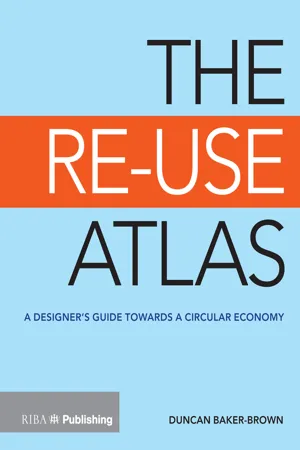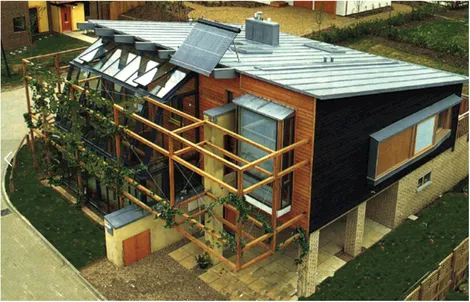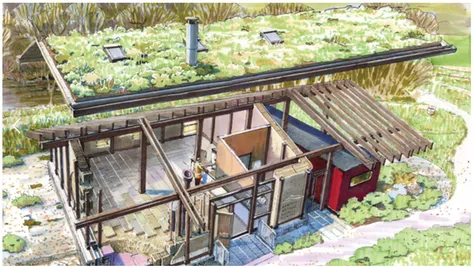
eBook - ePub
The Re-Use Atlas
A Designer's Guide Towards the Circular Economy
Duncan Baker-Brown
This is a test
- 192 pages
- English
- ePUB (mobile friendly)
- Available on iOS & Android
eBook - ePub
The Re-Use Atlas
A Designer's Guide Towards the Circular Economy
Duncan Baker-Brown
Book details
Book preview
Table of contents
Citations
About This Book
This book is a highly illustrated "map, " using photos, infographics and statistics, showing designers how they can successfully navigate the emerging field of resource management and the circular economy. Using the Brighton Waste House Project as a basis for this, the book will look at key moments and landmark decisions made during its design and construction, as well as the people and projects from around the world that inspired them.
Frequently asked questions
How do I cancel my subscription?
Can/how do I download books?
At the moment all of our mobile-responsive ePub books are available to download via the app. Most of our PDFs are also available to download and we're working on making the final remaining ones downloadable now. Learn more here.
What is the difference between the pricing plans?
Both plans give you full access to the library and all of Perlego’s features. The only differences are the price and subscription period: With the annual plan you’ll save around 30% compared to 12 months on the monthly plan.
What is Perlego?
We are an online textbook subscription service, where you can get access to an entire online library for less than the price of a single book per month. With over 1 million books across 1000+ topics, we’ve got you covered! Learn more here.
Do you support text-to-speech?
Look out for the read-aloud symbol on your next book to see if you can listen to it. The read-aloud tool reads text aloud for you, highlighting the text as it is being read. You can pause it, speed it up and slow it down. Learn more here.
Is The Re-Use Atlas an online PDF/ePUB?
Yes, you can access The Re-Use Atlas by Duncan Baker-Brown in PDF and/or ePUB format, as well as other popular books in Architecture & Architecture General. We have over one million books available in our catalogue for you to explore.
Information
PART 1
Setting the Waste Scene
| CHAPTER 1 Resource Matters |
| CHAPTER 2 What a Waste! |
| CHAPTER 3 The Political Narrative |
CHAPTER 1
Resource Matters
Duncan Baker-Brown
'It’s all about ‘managing resources’, and humankind has never been good at that.
Ever since our hunter-gatherer ancestors began to try alternative lifestyles around 10,000 years ago, humans have had ever-increasing problems finding resources. Although exhausting and dangerous, the hunter-gatherer technique followed the route of accessible resources. Settling down and relying on one place to provide everything required to satisfy human needs has always proved to be a big challenge. On occasion it has resulted in hunger and localised extinction of whole societies.
There are, however, many examples of long-established communities that have lived in harmony with their natural environments. Some of these still exist. Herbert Girardet in his book The Gaia Atlas of Cities1 states that as late as the 1980s, 13 of China’s major cities functioned as what many would define as sustainable cities, that is the city fed the hinterland and the hinterland fed the city. For some, that all changed when China embraced elements of the Western free market economy and broke away from its established closed-loop systems in search of linear consumerism.

It is, of course, a lot easier to find examples of humankind’s rampant consumption of resources. Our appetite for stuff is insatiable. There is a famous photograph by LA Hoffman which shows the last group of 23 North American bison in what is now Yellowstone National Park. In the 16th century there were between 25 and 30 million buffalo in North America.2 North American bison escaped extinction, just. Now a little over a century later there are about 15,000 of these (with many more cross-bred with domestic cattle), which are descended from those last 23 survivors. Humans do not know when to stop consuming resources. Acting in a measured, balanced and sustainable way does not come easily to human societies. That is why we are in the middle of a mass extinction of species and some resources are scarce, while even plentiful resources are difficult to access.
Many people just don’t believe there is a different way of existing. However, my colleague at the University of Brighton, Dr Ryan Woodard, cites the precise year when the UK ‘invented the concept of waste’: 1861. In that year, plundered resources from the British Empire made the country so resource wealthy that it could afford to make bricks solely out of new material. Up until that point rubbish was reused whenever possible. Perhaps one could conclude, therefore, that the idea of a linear economy has only been prevalent for around 150 years.
In the meantime, while pledging commitment to the United Nations climate change agreement COP21 (obviously good news) and with the EU publishing its own Circular Economy Package, governments around the world are nonetheless looking towards the most controversial method of extracting fossil fuels – ‘fracking’. Oil-rich countries flex their muscles defending their land or grabbing that of others. In addition, there is the very real problem of resource security. Even if you don’t have concerns about the destruction of natural environments due to the mining of minerals and the felling or burning of hardwood forests for palm oil plantations, there are just too many conflicts around the world to make the sourcing of raw materials safe and reliable. Still the UK government appears to want its citizens to burn their way out of the recent recession by dropping green energy incentives in favour of sponsoring the aforementioned ‘fracking’. There is precedent for this type of initiative. Immediately after World War II my London-based grandparents were encouraged to burn their coal fires through the night, simply to kick-start the bankrupt UK economy and get the coal mines busy again.
Despite this I am convinced that we are at the beginning of another Industrial Revolution: one that can take best advantage of ‘big data’, hyper-fast communication networks and, critically, a greater understanding of our host planet, to enable humankind to make well-informed decisions when considering which resource streams to tap into. It is well understood that many large corporations, academic institutions, NGOs and governments are considering ways of functioning in a more intelligent way that works with healthy natural circular systems. The stupidity of digging down for carbon in the ground while the sun burns your back is not lost on many people. Cradle to Cradle3 threw down the gauntlet to humankind, to stop beating itself up about the environment; to stop being ‘less bad’; to design circular systems instead of linear ones, and be positive while you do it, because this has the potential to improve the lives of many more people than our current linear system does – and it will do so while allowing Planet Earth to recover and heal. However, the most exciting bit of the Cradle to Cradle challenge for me is that it can only happen if we design new systems, materials, products and places that allow for circular systems to flourish. I also believe, as Freegle UK co-founder Cat Fletcher and many others do, that design will save the world, or at least be the catalyst that allows huge populations of humans to live in harmony with it. Sophie Thomas, the former director of circular economy at the RSA,4 underlined this point. During her time at the RSA, Thomas oversaw the ‘Great Recovery’ programme. In the paper ‘Rearranging the Future’5 Thomas states:
'Research has shown that over 80 per cent of the environmental impact of products we use every day is built in at the concept design stage, and that very little account is currently taken of the end-of-life implications of these designs. Moreover, if the system has not been designed to take account of the actual products, materials and behaviours that flow through it, there is very little point in merely changing the design of a single product. a keyboard designed for disassembly will still end up being shredded and put into the e-waste furnace unless a logistical system has been designed to divert it out of the existing infrastructure.

FIG. 1.1 Four design models developed by the RSA as part of its ‘Great Recovery’ programme, June 2013
As part of its ‘Great Recovery’ programme, and in effect in response to their own research, the RSA developed four design models for a circular economy, shown in Figure 1.1.
So are we progressing towards a circular economy?
Things are changing. More people – individuals, as well as multinational corporations – are concerned about where the materials that go towards manufacturing their products come from. More and more companies, large and small, are not prepared to put up with the negative PR associated with illegally mining the raw materials for their products, or the displacement of indigenous communities. Some of the largest companies supplying the construction industry are doing positive things to clean up the environment and promote equitable trade. The issue of ethics is now being taken seriously, and that huge topic is the subject of numerous books, exhibitions, conferences and symposia. At the same time, dropping the well-intentioned but much maligned and misunderstood word ‘sustainable’ from the environmental debate could be helping matters. The concept of the circular economy is more easily comprehended as a positive way of living in a smarter way that emulates natural systems and will give increased benefits to everyone.
As stated earlier, many human cultures have worked in harmony with their immediate
Origins of the Circular Economy
So where did the concept of the circular economy, or ‘economy in loops’ as it was initially explained, come from? In 1976 professor w alter Stahel, architect and industrial analyst, presented preliminary ideas on this to the european Commission. entitled ‘The potential for substituting manpower for energy’, it was co-authored by Genevieve Reday and described a future of an economy in loops, with its positive impact on job creation, economic competitiveness, reduced dependence on natural resources and the prevention of waste. Many people credit Stahel with coining the expression ‘Cradle to Cradle’ in the late 1970s. By 1981 he had synthesised his ideas in his award-winning paper ‘The product-life factor’,6 which identified a number of concepts that practitioners featured in this Atlas are putting to the test. For example, Stahel identified that the ultimate sustainable business model in a closed-loop economy would be ‘selling utilisation’ instead of products.
During the 1980s much work was being done by Stahel and also by professor Dr Michael Braungart, including the product-l ife Institute in Geneva and Braungart’s environmental protection encouragement Agency (nicknamed ‘the cradle of cradle to cradle’). Today there are a number of independent think tanks and academic institutes around the world doing fine work developing ideas, providing training schemes, and even certifying products, including the ellen MacArthur Foundation,7 formed in 2010 by the solo long-distance yachtswoman Dame ellen MacArthur with the specific aim of accelerating the transition to a regenerative circular economy. Combining thought, leadership and education with big business, this foundation has quickly become an influential think tank, a catalyst for discussion and a publisher of papers and books. In the summer of 2016 the University of Bradford awarded the world’s first Circular economy MBA to Gin Tidridge,8 who completed the course while working as a sustainability specialist for B&Q. There is momentum behind this concept.
environment. However, since the beginning of the Industrial Revolution, the consumption of natural resources has grown exponentially, and unsustainably. Today you can expect nearly 90% of the raw materials used in manufacturing to become waste before the product leaves the factory, while 80% of products get thrown away within the first six months of their life.9 However, material flow analysis conducted in 2010 by WRAP (Waste and Resources Action Programme) concluded that nearly 20% of the UK economy is already operating in a circular fashion.10 It went on to predict that this could rise to nearly 30% by 2020. The EU Circular Economy Package11 adopted in December 2015 outlined an Action Plan and included an annex with a detailed timetable for implementation. The document focuses on the number of new jobs and wealth generated by a circular economy. In the same year, WRAP published data predicting that an expansion of the circular economy could generate as many as 3 million new jobs and reduce unemployment by 520,000 across the EU by 2030.12
My personal journey towards a circular economy

FIG. 1.2 BBM’s RIBA h ouse of the Future, 1994
Since working on the ‘RIBA House of the Future’ in 1994 (see Figure 1.2), I have been interested in the numerous ingredients that go towards making truly sustainable developments. Over the years I have become more and more interested in unpacking the supply chain associated with construction projects, and trying out different material sources with the aim of CO2 reduction, the preservation of ecosystems and the creation of work. Many architects and designers clearly understand the principles of designing buildings that require little or no traditional energy sources to perform properly. The greater challenge it seemed, to both my partner (Ian McKay) and I, was the reduction of the carbon and ‘ecological footprints’ associated with the actual design, construction and occupation of said low-energy buildings: whole life costing, in other words. So, naturally, re-examining material sources and construction systems, in addition to issues of programme (what goes on in the buildings we design and what type of lifestyles they encourage), have been two of our main pursuits over the two decades (and counting) of practice and teaching that we have enjoyed.

FIG. 1.3 Sketch of Romney Marsh Visitor Centre, explaining how ...